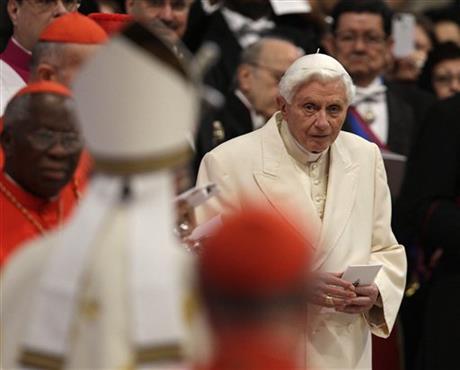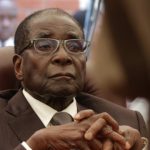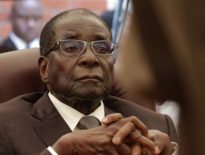VATICAN CITY (AP) — Retired Pope Benedict XVI joined Pope Francis at a ceremony Saturday creating the cardinals who will elect their successor in an unprecedented blending of papacies past, present and future.

Benedict discreetly entered St. Peter’s Basilica from a side entrance surrounded by a small entourage and was greeted with applause and tears from the stunned people in the pews. He smiled, waved and seemed genuinely happy to be there, taking his seat in the front row, off to the side, alongside the red-draped cardinals.
It was the first time Benedict and Francis have appeared together at a public liturgical ceremony since Benedict retired a year ago and became the first pope to step down in more than 600 years.
The significance of his presence was multifold, signaling both continuity and even a sign of Benedict’s approval of the 19 men Francis had chosen to join the College of Cardinals, the elite group of churchmen whose primary job is to elect a pope.
Francis’ choices largely reflected his view that the church must minister to the peripheries and not be a closed institution of rules but rather a place of welcome and mercy. He named cardinals from some of the world’s poorest countries, Haiti, Burkina Faso and Ivory Coast among them, tapping many pastors like him.
In a sign that Benedict still commands the honor and respect owed a pope, each of the 19 new cardinals — after receiving his red hat from Francis at the altar — went directly to Benedict’s seat to greet him before then exchanging a sign of peace with the other cardinals.
Over the summer, Francis and Benedict appeared together in the Vatican gardens to unveil a statue, but Saturday’s event marked one of the most important liturgical ceremonies a pope can preside over: the formal installation of new cardinals.
Saturday’s ceremony was thus the latest step in the evolving reality of having two popes living side-by-side inside the Vatican: Benedict’s presence marked the a new phase of reintegrating him back into the public life of the church after a period of being hidden away that began almost exactly a year ago with his Feb. 28, 2013 resignation.
With Saturday’s precedent, chances grew that Benedict would also appear at the April 27 canonization of his pope, John Paul II, and Pope John XXIII.
After processing down the central aisle at the start of the service, Francis went directly to Benedict, clasped him by his shoulders and they embraced. Francis greeted him in the same way at the end of the service, and Benedict removed his white skullcap in a sign of respect as Francis approached.
The crowd erupted in polite applause when one of the new cardinals, Secretary of State Pietro Parolin, greeted Benedict in his introductory remarks at the start of the service, saying We are grateful for your presence here among us.
Benedict, dressed in his white cassock with a long double-breasted overcoat, again smiled and waved.
Some people reached out to try to touch Benedict as he passed by, others tried to approach him to take his photo but were restrained by ushers.
The occasion for this historic first was Francis’ first cardinal-making ceremony to formally welcome 19 new princes of the church into the College of Cardinals.
He tapped like-minded cardinals from some of the world’s smallest, most remote and impoverished nations: Two hail from Africa, two from Asia and six from Francis’ native Latin America, which is home to nearly half the world’s Catholics but is grossly underrepresented in the church’s hierarchy.
There’s Cardinal-designate Chibly Langlois, who isn’t even an archbishop but rather the 55-year-old bishop of Les Cayes and now Haiti’s first-ever cardinal. Another Caribbean cardinal, Kelvin Edward Felix, was for a quarter-century the archbishop of tiny Castries, St. Lucia, population 163,000.
The archbishop of Managua, Nicaragua, Leopoldo Jose Brenes Solorzano, is an old friend who worked alongside the former Cardinal Jorge Mario Bergoglio in preparing the seminal document of the pope’s vision of a missionary church — the so-called Aparecida Document produced by the 2007 summit of Latin American bishops. Nicaragua’s second cardinal ever, Brenes has already made an impression at the Vatican with his unruly gray curls and the blue jeans he donned for the flight to Rome.
Cardinal Andrew Yeom Soo-jung, archbishop of Seoul, South Korea, has serious Catholic chops: His ancestors were among the lay people who brought Christianity to the Korean peninsula in the 19th century, and his great-great grandfather and his wife were executed as part of the Joseon Dynasty’s persecution of Christians, the Asian Catholic news agency UCANews reported. Of the six children in his immediate family, three became priests.
Though he hails from Burkina Faso, Cardinal Philippe Nakellentuba Ouedraogo sounded an awful lot like Francis in his 2013 Christmas homily. Nakellentuba denounced the inequality, injustice, poverty and misery of today’s society where employers exploit their workers and the powerful few have most of the money while the poor masses suffer.
One cardinal sat out the ceremony even as he made history by living to see it: Cardinal Loris Francesco Capovilla, aged 98, became the oldest member of the College of Cardinals, but due to his age couldn’t make the trip from northern Italy. His was a sentimental choice for Francis: For over a decade, Capovilla was the private secretary to Pope John XXIII, whom Francis will make a saint alongside Pope John Paul II in a sign of his admiration for the pope who convened the Second Vatican Council.
Capovilla, Felix and the emeritus archbishop of Pamplona, Spain are all over age 80 and thus ineligible to vote in a conclave to elect Francis’ successor.
___
Follow Nicole Winfield at www.twitter.com/nwinfield





